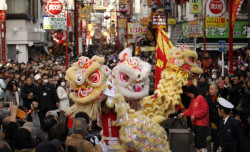
August 29, 2013
The Mediterranean World: Collections from the Louvre
The civilization of the sea at Ueno’s shrunken pond
By Metropolis
Originally published on metropolis.co.jp on August 2013
Japanese maps tend to place Japan at the centre of the world, with the Eurasian landmass to the left and the Pacific and Americas on the right. Culturally, however, there is much less assurance of Japan’s centrality. This is something that is underlined by the current exhibition at the Tokyo Metropolitan Art Museum, which presents a range of art objects and sculptures from the Louvre Museum.
Two hundred years after Napoleon’s defeat consigned France to secondary status amongst the great powers, the Louvre still continues to make a strong claim that France is at the centre of global culture, and one that Japanese audiences unwittingly find themselves endorsing by their deference for the great name of that institution.
While most people will associate the museum with its stunning collection of paintings, including the Mona Lisa, much more of its floor space is actually taken up by its vast historical collections. These present a narrative of France as a unifying nexus bringing together European culture and the Mediterranean civilizations that preceded it, including Egyptian, Greek, and Roman.
This is the focus of this exhibition—with important classical works—including excellent sculptures like The Paris of Landsdowne (2nd century), a marble copy of a famous statue of the legendary Trojan heartthrob whose love for Helen of Troy kicked off the Trojan War, and Artemis, Diana of Gabies (4th century BC).
This second statue is a tasteful work, thought by some to be by Praxiteles, one of the ancient world’s most famous sculptors. It portrays the later, sophisticated view of the important Greek and Roman goddess Diana (associated with hunting, chastity and childbirth) who in earlier incarnations was represented as a fierce, dangerous and multi-breasted fertility deity; and thus reveals the softening and ameliorating effects of artistic traditions in conjunction with religion.
While marble sculpture has its own aesthetic, it should also be remembered that statues like these were originally brightly painted and that the way they look today is merely a historical accident. For a clearer idea of how these works may have looked, check out some of the pottery and mosaics, especially Cupids Frolicking with Dolphins (3rd century).
This exhibition sets out not only to stake France’s claim to the legacy of Mediterranean civilization, but also points to its links with the Islamic world. There are a number of items of Islamic art as well as “Orientalist” French paintings, depicting what was often considered the exotic and enchanting world of the harem, including several works by Theodore Chasseriau. These works also evoke the world of the Barbary slave trade that not only enslaved Africans, but also sought out white women to service the seraglios of the sultans and the emirs of the Islamic world.
The timing of the exhibition to the summer months suggests that the curators are hoping that the exhibition will prove popular by evoking dreams of the Mediterranean Sea. If this is the intention, then the red-brick Met—set in the sultry humidity of Ueno Park, with its newly reopened but greatly shrunken decorative pond and fountains—is hardly an ideal venue.
Tokyo Metropolitan Art Museum, until Sep 23.









